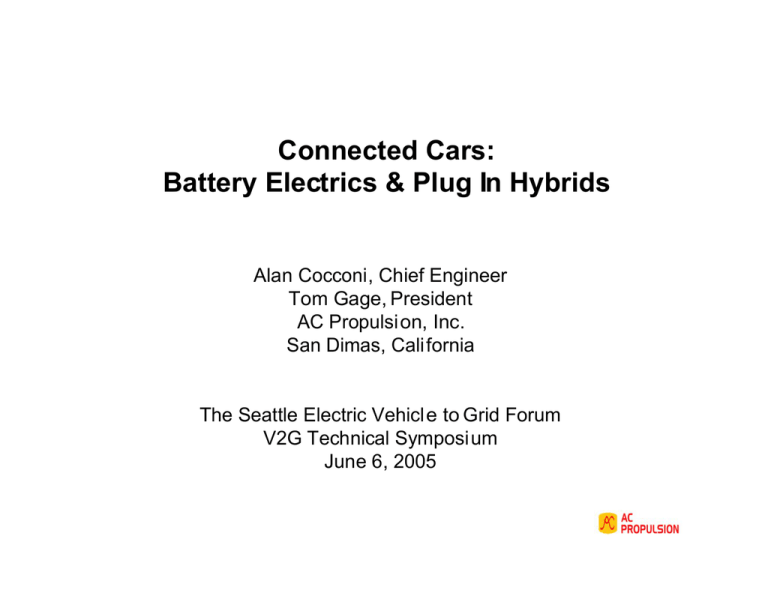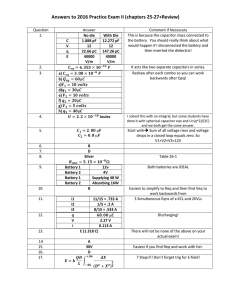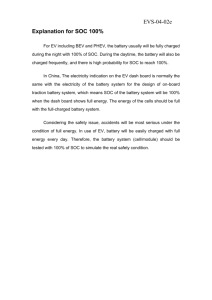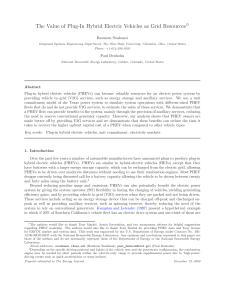Connected Cars: Battery Electrics & Plug In Hybrids
advertisement

Connected Cars: Battery Electrics & Plug In Hybrids Alan Cocconi, Chief Engineer Tom Gage, President AC Propulsi on, Inc. San Dimas, Cali fornia The Seattle Electric Vehicl e to Grid Forum V2G Technical Symposi um June 6, 2005 The Connected Car • Plugs in to the grid • Refuels whi le parked • Uses existing infrastructure • Adds to energy diversity • Presents offpeak load “Plug Bug” 2001 EV Conversion • Provides dispatchable power asset Major Automotive Transformations • 1900s - horses → cars effectiveness • 1970s - dirty engines → clean engines emissions • 2000s - mechanical → electro-mechanical efficiency ? 2010s - unconnected → connected energy Electricity Powers Transportation Without Petroleum V2G: An Evolving Concept • 1995 Amory Lovins proposes grid power from FCEVs • 1997 Kempton and Letendre paper on vehicle-to-grid, EVS1 4: Off-board fast chargers for grid support • 2000 Nissan Patent “Household Power Supply Using EV” • 2001 AC Propulsion first test bi-directional AC150 Gen 2, DaimlerChrysler - “We can use the energy unit in this car for homes or stationary power”, EPRI: “The Car of the Future May Help Pow er Your Home” • 2002 General Motors - “The car or truck would ... also be a power source... that can provide transportation, power or heat”, AC Propulsion demo of grid regulation by EV • 2003 AC Propulsion demo of grid-tied and stand-alone power from hybrid vehicle • 2005 The Seattle Electric Vehicl e to Grid Forum The Vehicle-to-Grid Concept - V2G Connected vehicles serve as distributed energy resource (DER) Grid Operator GPS Power Command $ $ Aggregator Wireless Provider Internet Driver Usage Profile and Preferences Power Response Key to V2G: Power Connection is Bi-Directional Power can flow to or from vehicle Conductive Connecto r DC Power 300 - 450 V 0 - 50 A Power Electronics Unit (Inverter) Motor • Grid-tied • Stand-alone AC Power 100 - 250 V 50 - 60 Hz 0 - 80 A Battery Electric • Full function: 0-60 < 10 secs, > 80 mph • Battery: 10 to 50 kWh, 300 to 1200 lbs • Range: 50 to 300 miles • Propulsion power: 70 to 150 kW • Charging pow er: 5 to 20 kW Battery Electric with Hybrid Generator RAV4 EV with range extending trailer Tejon Pass (elev 4144 ft) December, 2001 Plug-in Hybrid (Series Type) • Full function: 0-60 < 10 secs, 80 mph • Battery: 5 to 25 kWh, 150 to 600 lbs • Range: 20 to 80 electric, >350 gas • Propulsion power: 50 to 100 kW • Charging pow er: 5 to 20 kW 2002 Hybrid Conversion based on VW Jetta Plug-in Hybrid vs Gas-only 2004 Prius Engine Generator Traction Motor Transmission Battery Charger Charge port 1.4 liter 35 kW 30 kW 110 kW Fixed ratio PbA 8 kWh 650 lb 20 kW (V2G) conductive 1.5 liter 56 kW 20 kW (est) 50 kW Planetary NiMH 2 kWh 100 lb (est) none none Plug-In Hybrids Use Gas and Electricity 160 120 mpg 80 Prius gas-only hybrid 35 kW APU mounts in trunk Plug-in hybrid 40 0 0% 30% 60% % of miles driven on electricity 90% Plug-in Prius: 125 MPG • • • Plug-in Prius demo by Energy CS EVS-21, Monaco, April 2005 9 kWh battery 3 kW charger Control unit BEV vs PHEV: Function BEV PHEV • More electric range • More total range • Pure electric propulsion • Combined or pure electric propulsion • Battery and charger typically larger, better suited for most V2G services • Can generate bulk electricity from other fuel BEV vs PHEV: Cost BEV PHEV • Single power system • Dual power systems, more complexity • Larger battery • Emissions control hardware and warranty • Deep battery cycles • Smaller battery • Shallow or deep battery cycles Market Factors • Cost of ICE vs cost of battery – First cost – Operating cost • Value of extended range to customer • V2G optimality




